Found in Twin Peaks (S1 Pilot): Alice’s Blue Dress, The Queen of Hearts and Hidden “Adventure”

I’m back! If you missed the first post, you should definitely go back and read it to be briefed in some of the major themes relating Alice’s Adventures in Wonderland and Through the Looking Glass to Twin Peaks. FYI — I might sometimes reference Alice’s Adventure’s in Wonderland as AAIW, and Through the Looking Glass as TTLG just to make things easier on my lil ol’ fingers.
Season 1 - Pilot - “Northwest Passage”
The title of the pilot, “Northwest Passage”, was originally the title of the series, and the name of the North Dakota town it was to be set in. It was later changed to Twin Peaks because Northwest Passage is actually the name of a real town. Two observations here. The first is that the town had to be fictional, had to be a fantasy town. The second is that the commonly known Northwest Passage (the body of water, not the town) is what separates the Atlantic and Pacific oceans. It is a portal from one to the other. I think you can see the Through the Looking Glass reference here. Passing from one side to another.
“L” IS FOR LAURA PALMER
An interesting thing that jumps out from Through the Looking Glass is that at one point the woods make Alice forget her identity and she struggles to remember her name, thinking for a short time that it begins with “L”.
“…All she could say, after a great deal of puzzling, was, ‘L, I know it begins with L!’”
Starting with an “L”, Laura’s name also equates to be the same number of letters as Alice’s, for whatever that’s worth. Just be aware, I’m grasping for all possibilities here. Some things may have been pure coincidence. But, maybe not!
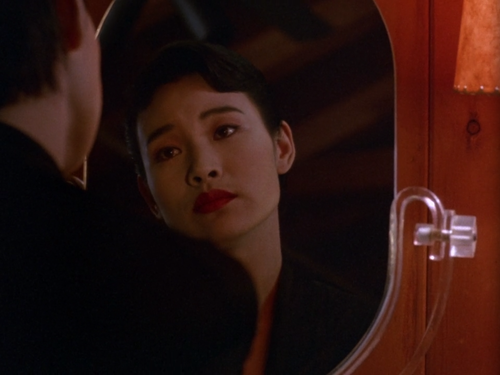
THROUGH THE LOOKING GLASS, LITERALLY
As soon as the pilot opens, we are introduced to doubles, which will be a theme throughout the series. There are two ducks in the river, followed by a shot of a lamp inside the Packard house that has two dogs on it, followed by a pan up to Josie, who sits staring dreamily into a mirror. Immediately, you can see the “Looking Glass” reference and it’s the first tip-off of Josie being one of the Alice characters.
Pete Martell grabs his canister of coffee. And Catherine is also drinking some. It’s our first introduction to coffee and it has happened almost immediately. Food and drink (coffee and sweets), as well as smoking, all play important roles in Twin Peaks. Just as tea, bread and butter, ham sandwiches, sweets, mushrooms and hookah smoke all play parts in Alice’s world, so I’ll continue to point these out in Twin Peaks.

“ASLEEP” BY A TREE TRUNK
After leaving to go fishing, Pete Martell discovers Laura’s dead body on the sandbank of the river, laying at the base of a — very large — tree trunk. Alice similarly falls asleep on a bank in Alice’s Adventures in Wonderland. Though the tree trunk is not mentioned in the books, it is a visual element in the Disney movie Alice in Wonderland – at the base of a tree is where Alice nods off and embarks on her journey into dreamland. I find the extremely large size of the tree where Laura’s body lay interesting because in AAIW, Alice is constantly shrinking and growing based on what she consumes. And Laura’s body looks so oddly tiny laying next to that giant tree trunk. There will be more fun with sizes that pop up later.
The woods are very important in both Alice’s world and in Twin Peaks. In both, the woods hold host to many bizarre characters and supernatural events. In the opening of Twin Peaks, we see the woods being processed at the mill — it’s being cut up for distribution. I think that we can also assume many of the places in Twin Peaks are built from the surrounding woods. Look at The Great Northern, in all its beautiful wooden interior glory and prized animal heads, and all the bizarre things that happen in the hotel — from Cooper’s riddle-filled dreams, to the very odd room service waiter that delivers milk to Cooper after he is shot, to Josie’s fate of being sucked into the wooden dresser. It can basically be seen as part of the woods itself.
BOBBY IS LATE FOR A VERY IMPORTANT DATE
When Mrs. Palmer discovers Laura is missing, she calls Bobby’s coach to see if Bobby knows where to find Laura. “He’s been late everyday this week, Mrs. Palmer. And last week, and maybe even the week before…” Skipping ahead to later, when we see where Bobby actually is — drinking coffee and waiting in the Double R Diner for Shelly — Bobby says to a waitress who walks in late:
Bobby: “I thought you Germans were always on time.”
Norma: “I thought the only time you cared about, Bobby, was makin’ time.”
Then, as Bobby leaves with Shelly, he turns flirtatiously to Norma:

Interesting that Bobby keeps being associated with time, like the White Rabbit in AAIW. Then, he and Norma both play with the possibility of meeting up in a dreamworld. Bobby also can be seen as escorting the Alice-type character of Shelly down a rabbit hole of lust and excitement and away from her real life with her wife-beating husband Leo.
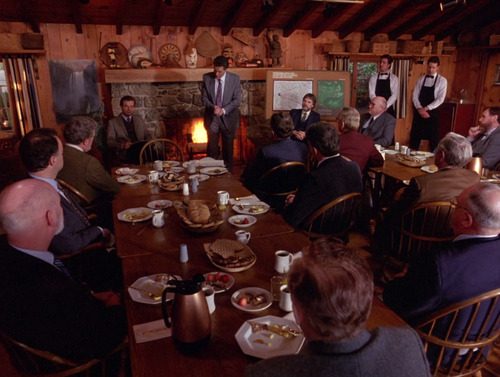
Jumping back to our first introduction to the The Great Northern, we see the Norwegian investors all scattered amongst quite the “tea party” spread of food and drink as they discuss the project to essentially demolish the Ghostwood National Forest that surrounds Twin Peaks. We will learn later that Ghostwood holds unusual supernatural places like the Owl Cave and the entrance to the Black Lodge.
I think Ben Horne is the (mad) Hatter. The Hatter is after all a businessman. And Ben Horne does go extremely mad as the series goes on. We haven’t met him yet, but I think Jerry Horne is the March Hare to Ben’s Hatter, the March Hare being the foil to the Hatter — they are a rude, nutty and almost kind of paranoid pair at the tea party Alice attends. But I’m getting ahead of myself!
After Laura’s parents, Sarah and Leland, find out that Laura is dead, we cut back to Mrs. Palmer shrieking in agony. There is a shot where the camera slowly follows the spiraling black cord of the dropped telephone receiver all the way down to where it rests on the ground. Angelo Badalamenti’s piano music that accompanies it matches the visuals and brings the chords lower and lower — as if we are falling falling down a rabbit hole.
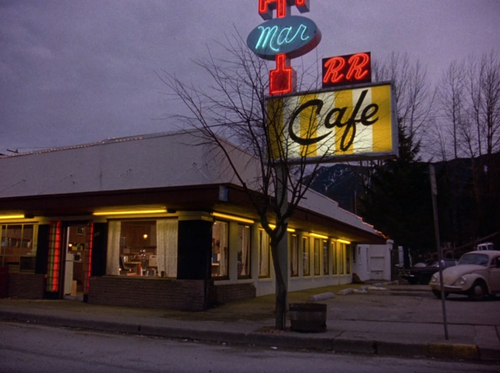
Ok, so back to the Double R Diner… first of all, doubles again. Does the Double R stand for Rest & Relaxation? Some good R&R could induce a dream state.
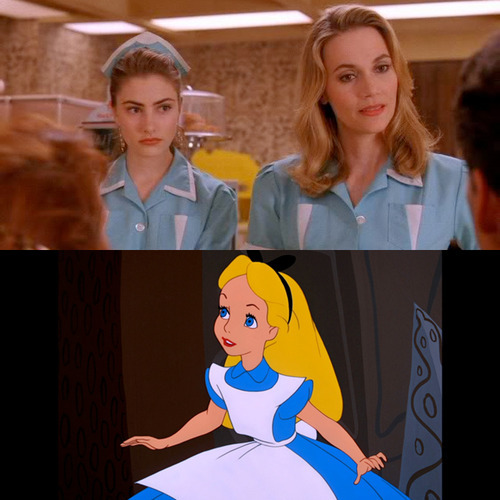
ALICE’S BLUE DRESS
The Double R stands out in scenery and costume in its relationship to AAIW and TTLG. The waitress outfits feel classically Alice by design, in their old fashioned appeal and apron-like function, as well as the iconic blue and white colors, which have been used since 1903.
Briefly, the original drawings that accompanied Carroll’s stories were drawn by John Tenniel. When colorized versions of Tenniel’s drawings started to be published in new editions of the books, the artist was not involved and Carroll had already passed away. Though many variations of color were chosen, 1903 featured one of the earliest colorized illustrations, published by Macmillan and showing Alice in a blue dress. After that, the blue dress became the most well-known, and eventually iconic, version of the dress.
In terms of scenery, the floor of the Double R is also checkered red and white, just like the chess board in TTLG, but you don’t see that really in the pilot. The diner is also known for its great coffee and pie. Drinks and sweets are also essential to Alice in AAIW, when she is trying to shrink and grow to become just the right size she needs to be. Essentially, the diner is the perfect place for two of our main Alices — Shelly and Norma — and it also operates as a sort of safe place for the both of them.

A MORE “ADVENTUROUS“ SHELLY
When Shelly leaves the diner and gets into Bobby’s car, she behaves differently. A wild, more adventurous, side comes out, and while they are driving she takes a swig from a flask. She says: “It’s happy hour in France.” Keep in mind that Alice eats and drinks to grow and shrink in the stories. In TTLG, Alice is also told to speak French if she doesn’t remember the English word for something. Not sure if this is a concrete connection, but it stuck out to me. Specifically, the Red Queen says to Alice:
“Speak in French when you can’t think of the English for a thing… And remember who you are!”

LELAND’S “LITTLE GIRL” AND CARROLL’S POSSIBLE PERVERSIONS
When Leland is taken to see Laura’s body, he breaks down while calling her “my little girl” and “my baby”. It’s a little odd when you think about how close to adult she is — she’s 17. She’s not a child like Alice, who is said to be around 7 years old, though that’s how Leland is seeing her. But, parents… I get it. Until SPOILER ALERT… it only intensifies the gross factor when you think about the fact that Leland, possessed by BOB, has been raping Laura since a very young age. Related to that (or, not not related)… something that I found out doing some research is that Lewis Carroll (which is the pseudonym for Charles Dodgson) has been debated as being a pervert. Among being a mathematician and a writer, he also took photos of children, some of them in the nude. Some argue that this should not really be looked at through the lens of our times, and that societal rules were different in the 1800s, and that this was for art, not for perversion. But I would say the line between art and perversion is often blurred and abused by artists. Just because something is more accepted during a certain time period (see: all things Kardashian) doesn’t really mean it should be. Also, Dodgson was said to be friends with children and actually the stories of Alice originate from rowing trips he would take with his friend Robinson Duckworth (amazing name) and the young Liddell sisters, who were his audience. Alice is quite likely based on one of the sisters — the real life Alice Liddell — who is also said to have been an unrequited love of Dodgson’s, though that is widely debated. Nevertheless, pervert or not, the possibility of him being a secret creep is relevant to the Leland character, and could have influenced Lynch’s approach to the way in which he corrupts the Alice in Wonderland stories. But who knows!
Ok… that’s out of the way.
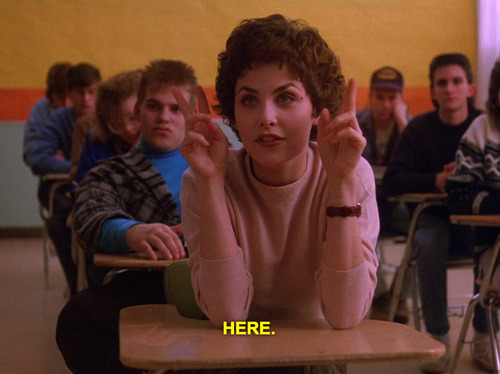
At Twin Peaks High School, Audrey Horne’s name is called during roll call. In a very dreamy move, she puts air quotes up when she says, “Here.” She is physically there, but mentally speaking she might be in a daydream.
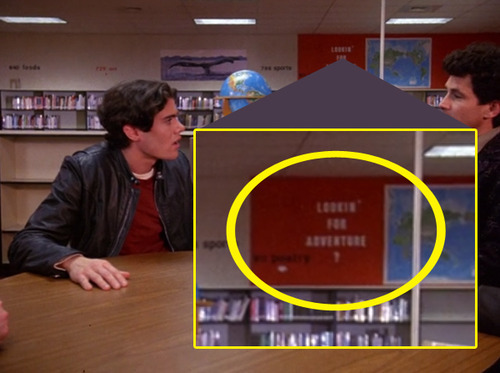
HIDDEN “ADVENTURE”
When Bobby is being questioned in the Twin Peaks High School library, the back wall has the phrase “LOOKIN’ FOR ADVENTURE?”. Alice’s Adventures in Wonderland! Oddly though, it sits right above the “Poetry” section instead of “Travel”… Alice encounters and recites poetry everywhere throughout the Carroll books. Interesting that the those are paired so closely.

TRAPPED BEHIND THE LOOKING GLASS
For the first of many times, we see Laura in a picture frame. That picture perfect image of prom queen Laura is trapped in that photo, smiling back at us. She won’t be coming back out. The picture serves as a looking glass into a world where Laura still exits, and is still an innocent.

THE QUEEN OF HEARTS, CATHERINE MARTELL
Back at the saw mill, Catherine Martell Packard is ordering Josie around with venom. As mentioned in my previous post, she very much resembles the Queen of Hearts, who insists on beheadings at any slight problem she faces. Catherine goes so far as to fire a random person just because she is in a bad mood, and to exercise her power.
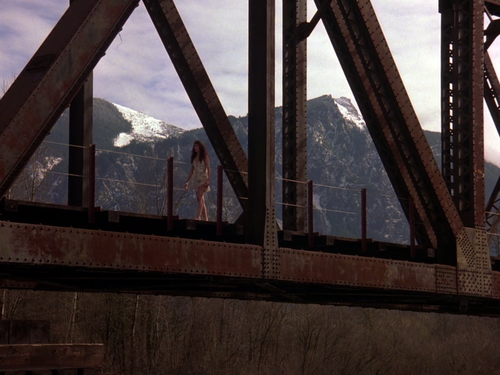
BETWEEN TWO WORLDS
In one of the most chilling shots of the series, we see Ronette, another girl who was involved the night Laura was murdered. She is walking across a bridge, and behind her are the twin peaks. Visually it looks like she is crossing from one peak to another, almost like she is walking through the looking glass. Is she stepping out of a dream/nightmare?
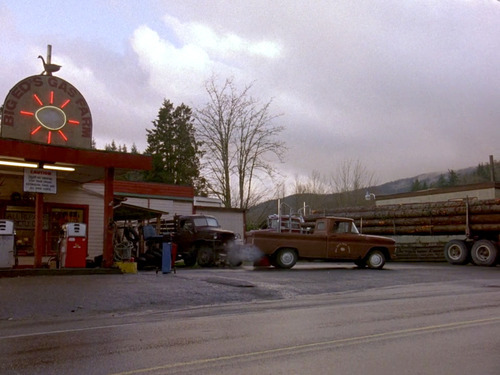
EGG HEAD ED
Ed Hurley’s gas station “Big Ed’s” has an egg on it. Humpty Dumpty makes an appearance in TTLG. “Big Ed” sounds like big head, which is what Humpty Dumpty looks like, but I know I am making a huge reach here. I have what might be a much better connection with a different character to Humpty Dumpty coming later. But Ed is trying to balance a lot, as we will learn later on, with his relationship between Norma and Nadine. He’s balancing on a wall, so to speak.
Aside from what might be a Humpty Dumpty connection, the sign also portrays another children’s allegory from Aesop’s fables, which is the story of the Goose that Laid the Golden Egg.
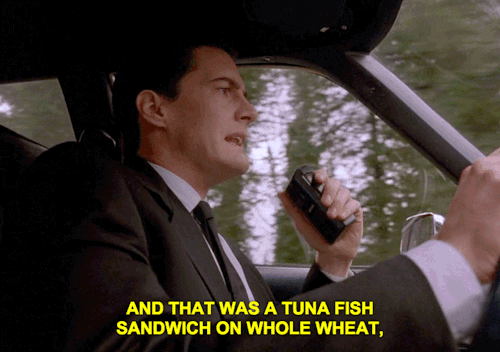
DINAH VS. DIANE
We finally meet Cooper! And he’s talking to himself, well into his recorder, which will later be sent to his assistant Diane (who we never meet). As mentioned in my previous post, this behavior mimics what Alice does with her cat named Dinah. Dinah and Diane have the same amount of letters, and are very similar names. We never actually meet Diane, and in that way she remains unresponsive in conversation, just like a cat would. We get to hear what Alice and what Cooper are thinking internally with these devices. Worth mentioning also is that Cooper is already talking about the food he’s been eating, the coffee he’s been drinking, and how great it is.

CONFUSED IDENTITY
When Cooper is taken to the hospital to see Ronette, the nurse implies she has lost her identity. “The girl doesn’t even know where she is. Or if she is.” Alice is constantly confused by her whereabouts in her dream world. There is also a lot of playing around with Alice’s identity in the books. At one point she is told that by entering the forest she might forget who she is… and she does. As mentioned at the top of this post, she thinks her name starts with an “L”. Alice also worries in Wonderland that she actually is someone else entirely. When Alice plays, she says that she would pretend to be different people. Alice is also always lost. She is constantly asking for directions in the books.
“I wonder if I’ve been changed in the night? Let me think: Was I the same when I got up this morning? I almost think I can remember feeling a little different. But if I’m not the same, the next question is, Who in the world am I? Ah, that’s the great puzzle!“ — Alice in Alice’s Adventures in Wonderland
Later on in the pilot, Cooper reads an entry from Laura’s diary, which focuses on her childlike tone and food. She says, “Asparagus for dinner again. I hate asparagus. Does this mean I’ll never grow up?” The scene ends with Cooper saying to his recorder, “Diane, I’m holding in my hand a small box of chocolate bunnies.” Another detail playing to Laura’s childish side. And another food mention.

MIRRORED IMAGERY
In the background behind Lucy there is a poster that features the woods being reflected into a body of water. The reflection is crisp, creating a mirrored “looking glass” effect.

MIX OF ALICE AND THE HATTER
I mentioned in my previous post that I think there are multiple Alice characters. Audrey Horne could be some kind of cross between a mad Hatter character (which would make sense since her father — I think — is the Hatter), and an Alice. She is most definitely bored, and her boredom gets her into a load of adventurous situations down the road. She has an innocence about her, but she has an edge that makes her crave trouble. We see her change her attitude by switching from saddle shoes to bright red high heels at school. She is living a double life. From the Hatter perspective… she’s oddly smiling in school at the prospect of Laura’s death, she mirthfully pokes a hole in the concierge’s coffee cup and spills coffee everywhere, and she causes theatrics over Laura being dead to get the Norwegian businessmen to pay attention to her. She’s a troublemaker creating her own adventures.
Ok — that’s enough for now. We’re halfway through the pilot! More to come! Thanks for reading!
Go further down the rabbit hole with my previous posts.
- Celia Q.
Notes
captainquixotic liked this
mgfh-blog liked this
celiaq reblogged this from twinpeakswonderland
twinpeakswonderland posted this